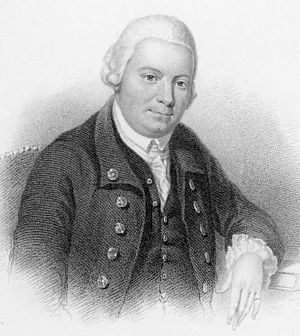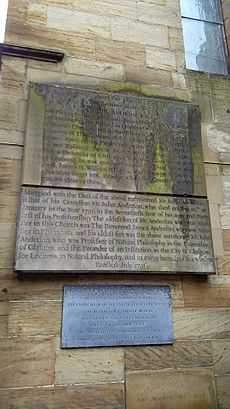John Anderson (natural philosopher) facts for kids
Quick facts for kids
John Anderson
FRSE FRS FSAScot
|
|
|---|---|
 |
|
| Born | 26 September 1726 |
| Died | 13 January 1796 (aged 69) |

John Anderson (26 September 1726 – 13 January 1796) was an important Scottish scientist and teacher. He lived during the Industrial Revolution. He believed in using science to help technology grow. He also wanted to educate and help ordinary working people.
Anderson helped start the Royal Society of Edinburgh. After he died, his ideas led to the creation of Anderson's College. This college later became the University of Strathclyde.
Contents
Early Life and Education
John Anderson was born in Rosneath, Dunbartonshire. His father and grandfather were both well-known church ministers. After his father passed away, John was raised by his aunt in Stirling. He went to grammar school there.
In 1745, he earned his Master of Arts (MA) degree from the University of Glasgow. During the Jacobite Rising of 1745, he served as an officer in the army.
From 1755 to 1757, he was a professor at the University of Glasgow. He taught Church History. Then, from 1757 to 1796, he became a professor of Natural Philosophy. This means he taught science, especially physics. He was the longest-serving science lecturer in the 1700s.
A Leading Scientist and Inventor
In 1760, Anderson became a professor of natural philosophy at the University of Glasgow. He really enjoyed this job. He focused a lot on physics. He loved doing experiments and working with machines and inventions.
He encouraged James Watt as Watt developed his famous steam engine. Anderson also knew Benjamin Franklin. In 1772, Anderson put the first lightning conductor in Glasgow. This device protects buildings from lightning strikes.
Anderson also wrote an important textbook called Institutes of Physics. It was published in 1786. This book was very popular and was printed five times in just ten years. He was chosen to be a Fellow of the Royal Society. This allowed him to meet many other top scientists of his time.
Education for Everyone
John Anderson's biggest passion was providing "useful learning" to the working class. He especially wanted to show them how science could help industry. He did this alongside his university work. He gave special evening lectures for skilled workers and craftspeople.
In these popular lectures, he focused on experiments and demonstrations. He loved setting off explosions and fireworks. Because of this, people nicknamed him "Jolly Jack Phosphorus".
Supporting New Ideas
Anderson was also known for his radical political views. He supported the French Revolution. In 1791, he invented a new type of six-pound gun. He gave this gun to the French National Convention. He called it "the gift of Science to Liberty."
While he was in France, Germany blocked French newspapers. Anderson suggested sending pamphlets into Germany using small hydrogen balloons. This was done. Each balloon had a message that said, "O'er hills and dales, and lines of hostile troops, I float majestic, bearing the laws of God and Nature to oppressed men, and bidding them with arms their rights maintain."
Founding a University
Anderson used his lectures for working people as a base for his biggest dream. He left his property to start a school in Glasgow. He wanted it to teach "useful learning." It was called Anderson's Institution or Andersonian University.
This school was very successful. For example, a young millworker named David Livingstone studied there. He later became a famous missionary doctor and explorer. Anderson's Institution changed its name many times. It also joined with other colleges. Today, it is known as the University of Strathclyde.
The university still honors John Anderson. The physics building and the main library, the Andersonian Library, are named after him. The city center campus is called the John Anderson Campus.
John Anderson passed away in Glasgow when he was 69 years old. He is buried with his grandfather in Ramshorn Cemetery in Glasgow. On January 13, 1996, the University of Glasgow placed a wreath to mark 200 years since his death.

